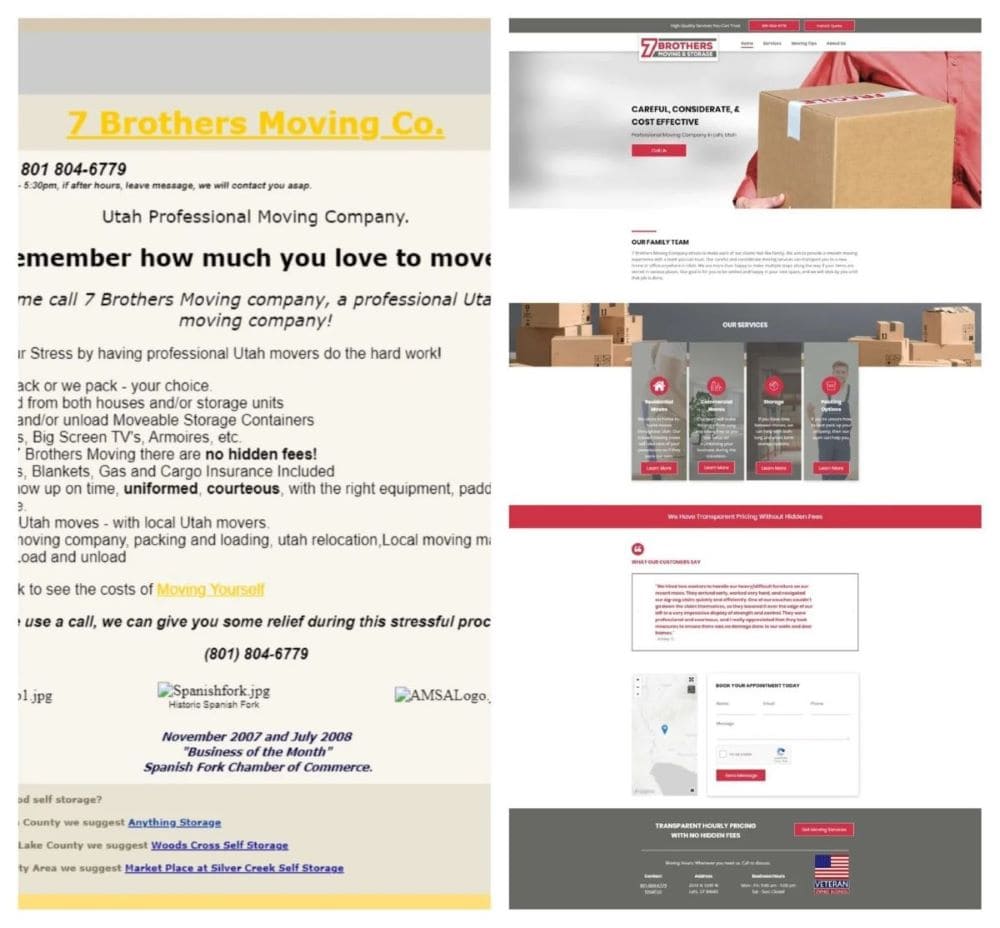The digital world evolves often as a result of changing trends or algorithm updates. As a result, business websites need to change along with it. Knowing how to update a website is essential to achieving success online and maintaining an online presence.
Whether your website needs to be better optimized or could use a fresh look, this article covers 11 steps for how to update a website. Jump below to see what those steps are!
Table of Contents
- How to Update a Website: 11 Steps
- Is a Website Update Necessary?
How to Update a Website: 11 Simple Steps
1. Check for Security Vulnerabilities
If you do nothing else to your website, remember to update the security measures. If you decide not to do this, you could put your business and your customers at risk. Add these five specific tasks to your website update checklist:
- Update all your software and add-ons
- Install a web application firewall
- Activate SSL encryption
- Use a strong password
- Backup your data
- Activate SSL encryption
2. Review Analytics for User Behavior Data
Examining user behavior data in Google Analytics is crucial for a website update. It offers valuable insights into how visitors interact with your site, such as user patterns, preferences, and pain points.
Check the bounce and exit rates to identify the web pages people drop off most often. Analyze each one deeper to determine what’s causing people to lose interest. Use this data to guide informed decisions for website updates to which your target audience will respond well.
3. Run A/B Tests to Increase Engagement
If your website is generating enough traffic to get worthwhile data from an A/B test, we strongly recommend doing so. A/B tests uncover critical details about how people engage with your website. These tests focus on improving conversion rate optimization.
Conversion rate optimization (CRO) is the process of updating websites to increase conversions and engagements. CRO goes beyond just optimizing CTAs (calls-to-action). A/B tests (or Split Tests) also analyze whether specific colors, messaging, and page layouts increase user engagement.
Websites that don’t generate much traffic won’t gather as definitive data as those with a larger testing pool. However, you can still run A/B tests and begin the process while your website grows its traffic.
4. Check What Your Competitors are Doing
Keeping an eye on what competitors are doing can give businesses ideas for how to update a website. Find inspiration into how your messaging can be more informative, improve the user experience, simplify the checkout process, and more.
Compare your website to your top competitors and note anything missing, such as information, specific pages, certain functionalities, etc. Use a tool like Semrush to see what keywords your competitors are targeting and outranking your website.
Use this information to guide your website update, whether elevating the design or creating high-quality content to target relevant keywords.
5. Update Misinformation & Outdated Content
Refreshing outdated information and correcting inaccurate information is essential to maintain accuracy, relevance, and trustworthiness. Regular website updates ensure your target audience sees current and reliable content.
Not only does this develop trust between people and your brand, but also with search engines. As a result, this works to boost your website’s rankings online.
If you have outdated content because of specific words or dates, we recommend using Screaming Frog to run a Custom Search crawl that will identify those instances for you. Using your time efficiently and effectively is the top priority for website admins and marketers. Screaming Frog is a long-standing favorite for its extensive features and capabilities.
6. Learn How to Update a Website for Better SEO
A website update is incomplete without optimizing for SEO. Having a well-designed and functional website is essential, but you need search engine optimization to get people to visit your website.
Your website update should address the SEO needs discovered during a site audit. Each website varies with updates that are needed, but standard SEO optimizations include:
- Redirecting broken links
- Targeting more relevant keywords
- Optimizing metadata for better CTRs (click-through-rates)
- Updating existing content to deliver more value to your target customers
- Creating new content to capture keyword opportunities
- Implementing strategic internal links to the most valuable pages
- Optimizing for faster site speed
- Fixing critical user experience issues
We foremost recommend conducting a site audit to guide you in the types of SEO website updates that need to be made.
Don’t have the time to do this for your clients? Boostability’s white label SEO services will ensure that your client websites are supported and optimized. We partner with agencies like yours and operate as an extension of your time directly under your brand!
7. QA Your Website to Ensure Everything Works
Sometimes, a website update overhaul becomes so focused on adding new bells and whistles to the website that it neglects old functionality. Ask yourself the following questions:
- Does your website load too slowly?
- Is your website responsive across all devices and screen sizes?
- Do all the main parts of the website still work?
- Did you remove pages you linked to in other parts of the website, creating redirect chains or loops?
- Are the social media widgets and other buttons still properly synced?
- Do the videos play in excellent quality?
- Are any images broken or have they disappeared?
Design is an important component of knowing how to update a website, but functionality is essential. Consumers now will not waste time leaving a website that doesn’t work for them or is too difficult to navigate.
Run consistent QA (quality assurance) of your website so that nothing slips through the cracks and hurts your user experience!
8. Simplify the Navigation & Conversion Process
Simplifying a website’s navigation and conversion process is imperative for several reasons.
First, ensuring the website loads quickly is critical. People expect immediate access to what they’re looking for, whether that’s information or products. Fast-loading websites enhance user experience, reducing frustration and bounce rates. People are more likely to stay on your website when it loads quickly.
Second, websites must be easy to navigate so that people can find what they’re looking for as quickly as possible. Simplifying your menu, footer, and how your website is laid out minimizes confusion. It also enables people to explore and stay on your website for longer.
Third, the goal of a website update is to make the conversion process as concise and straightforward as possible. Simplify the conversion process to minimize distractions that would stop somebody from completing the desired action.
As a rule of thumb, it should take no more than three steps to get people to take a desired action, such as a product purchase or a lead form submission.
9. Upgrade Your Design to Relevant Trends
Refreshing a website’s design to align with current trends is crucial for maintaining relevance and creating a modern, visually appealing digital presence. This website update enhances user experience by incorporating the latest design principles, optimizing layouts for mobile responsiveness, and creating intuitive navigation.
Staying current with design trends not only sets the website apart from competitors. It also reflects the evolving identity and values of the brand. Web design is a strategic investment in both aesthetics and functionality, contributing to a positive first impression and sustained engagement with users.
Work closely with a web designer to achieve a cohesive, user-friendly, and modern design!
10. Use High-Quality Visuals
Websites must feature high-quality images, videos, graphics, and any other visual their target audience likes. They are highly effective in capturing and retaining user attention.
Compelling visuals enhance the site’s overall aesthetics. It’s also a strategic SEO move to increase engagement and make content easier to digest. User experience is closely tied to the success of SEO. Visual elements hold a lot of weight in enhancing the UX of websites.
Clear, sharp images and engaging graphics contribute to a professional and trustworthy online presence, instilling confidence in users. Moreover, videos have a 52% retention rate. Get creative with how you display visuals on your site. Add video marketing into the mix, along with images and graphics.
Just remember to optimize your images for image SEO best practices and videos for YouTube SEO. Last but not least, compress the sizes so they don’t slow down your website speed.
11. Seek Feedback from People
Businesses should actively seek feedback from customers and site visitors regarding their websites to gain valuable insights into user experiences, preferences, and potential pain points. Customer feedback serves as a direct line to understanding what works well and what needs improvement. This enables businesses to align their online presence with user expectations.
This feedback is particularly crucial during a website update, as it helps to identify areas for enhancement and ensures that the changes made resonate positively with the target audience. By involving customers in the update process, businesses can address specific concerns, refine user interfaces, and ultimately create a more user-friendly and engaging website.
This collaborative approach not only fosters a sense of inclusivity but also increases the likelihood of the updated website meeting user needs and contributing to overall customer satisfaction and loyalty.
Is a Website Update Necessary?
Website updates are essential to keep businesses relevant online and rank higher in SERPs (search engine results pages).
68% of online experiences start on a search engine. If business owners do not update their websites, they risk losing business to their competitors and dropping in rankings. The main reasons for updating websites include:
Website Updates Fix QA Problems
An obvious reason for a website update is to fix anything that’s wrong with it in the first place. It doesn’t matter how well-built a website is; things are bound to break at some point from updates or other reasons. Quality assurance should be conducted on your website to find anything that’s not functioning properly, is broken, or is diminishing the user experience.
Website Updates Increase Security
Regular website updates increase the safety of your website and your website visitors. Malware attacks grew by 358% within a year. Hackers are becoming more discreet and sophisticated with their tactics, making both people and websites more vulnerable.
Understanding how to update a website for enhanced security is crucial for all businesses, especially for those that collect personal information from their customers.
Website Updates Increase Online Rankings
Search engines like when companies update their websites. A website update signals search engines that you are actively improving the user experience and content. Active websites that are properly optimized for SEO will increase their online visibility by ranking higher in SERPs.
Website Updates Deliver Mobile-Responsiveness
Nearly 60% of all global website traffic comes from a mobile device. To achieve high rankings, your website MUST be mobile-responsive — it’s a ranking factor. Businesses risk losing online visibility, which will hurt their ability to bring in online traffic and revenue if their sites are not responsive.
Mobile-responsive websites look great, load quickly, and function seamlessly across devices of all shapes and sizes. A consistent website update routine ensures that your website doesn’t fall short in any of these areas.
Website Updates Enhance User Experience
New trends emerge constantly and information can become outdated. A website update ensures that you’re delivering a quality user experience by creating content that your target audience finds valuable.
Keyword trends and performance are also subject to fluctuation. Staying on top of your keyword strategy is essential for SEO. When businesses update their keyword strategies, a website update is necessary to capture the new keywords on the site.
Businesses also have a responsibility to display accurate, updated information on their sites. When information becomes outdated or inaccurate, business owners must do their due diligence to either remove false information or update it to reflect the latest studies and data.
Website Updates Create a Great First Impression
Websites often serve as the first impression potential customers have with a business. Having an old website design can make your company look outdated and distrustful.
If people don’t like what they see or it’s difficult to find the information they’re seeking, they will leave. Having a poorly designed and dysfunctional website results in losing potential clients.
For example, the picture on the left is the original version of the website. The one to the right is the same business after a website update.

Understand How to Update a Website to Achieve Ongoing Growth Online!
Knowing how to update a website is fundamental to achieving success online and maintaining your website’s online presence. Digital marketing is not a one-time solution — it’s an investment that requires ongoing maintenance.
Such maintenance can require extensive knowledge, time commitments, and resources. Boostability is a white label partner to agencies that need help in fulfilling SEO campaigns for their clients.
Our SEO experts operate behind the scenes, carrying out successful SEO campaigns on your behalf that will help your clients achieve their organic and online goals! Learn more about our white label SEO services and process here.









